A Full-Funnel Marketing Guide for Higher Education

What is Full-Funnel Marketing for Higher Education?
At its core, full-funnel marketing means investing in upper-funnel awareness and mid-funnel consideration strategies to drive lead generation efforts and investing in post-inquiry marketing to continue to nurture prospects into students.
While we like to think of the student journey as a linear process and clear path that every student follows, the reality is that every student journey is unique, and it rarely follows the exact path we proscribe. In spite of this reality, it is helpful to understand the stages of the journey that all prospective students must go through in some form. Understanding the stages of the student journey allows us to deploy a full funnel approach to our marketing and enrollment management efforts – one that takes a holistic approach and creates a student-centered experience that is more likely to result in better outcomes for your marketing efforts and ultimately your students.
Rather than focusing marketing efforts on lead generation efforts, a full funnel marketing approach invests in upper funnel activities and post-inquiry student engagement opportunities. Upper funnel marketing builds awareness and educates prospective future students. Down funnel pre-post-inquiry marketing nurtures prospective students, builds a relationship and helps the student move from consideration to enrollment and graduation.
In this article we will discuss the following topics:
- Understanding the Student Journey – Breaking down the key stages of the student enrollment funnel.
- The Importance of a Full-Funnel Marketing – Why taking a holistic approach to student recruitment is essential for growth and sustainability.
- Growing Enrollment with Full-Funnel Marketing – Key Performance Metrics (KPIs) to monitor and measure along the student journey.
Understanding the Student Journey
The student enrollment funnel is a critical framework for understanding the path prospective students take from initial awareness to becoming enrolled students. By recognizing the key stages and the specific needs of students at each point, institutions can tailor their outreach and support to maximize enrollment success.
Here’s a breakdown of the key stages of the student enrollment funnel:
When prospective students are just starting to consider higher education or specific programs, they are forming their first impressions on a variety of universities. This broad stage is your institution’s opportunity to grab their attention and inform them of who you are. The goal here is the craft and deliver messaging that excites your prospective students to learn more and easing them into the next stages of their decision-making journey.
Grab the attention of these prospective students so that they’re aware of your institution through these channels:
- Search
- Social media
- Over-the-top (OTT) advertising
- Program Display
- Audio
- Video
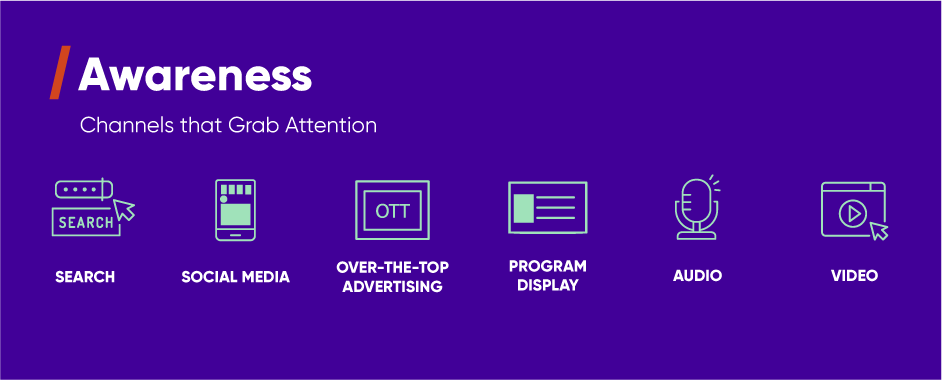
Crafting and delivering messaging that focuses on your institution’s unique strengths such as innovative programs, a vibrant campus life, outstanding online options, or personalized student support can be beneficial for guiding potential students through the early stages of their decision-making journey.
2. Consideration:
At this stage, students have narrowed their focus to a few institutions and are actively researching their options. This consideration stage is recognized as the longest in the student journey, lasting from the moment they first become aware of colleges all the way through enrollment. During this extended period, prospective students constantly revisit and refine their choices, narrowing down their top pick schools. According to our latest Online College Students Report 2024, a majority of students have at most three schools in their consideration set. This highlights the importance of maintaining engagement throughout this critical phase.
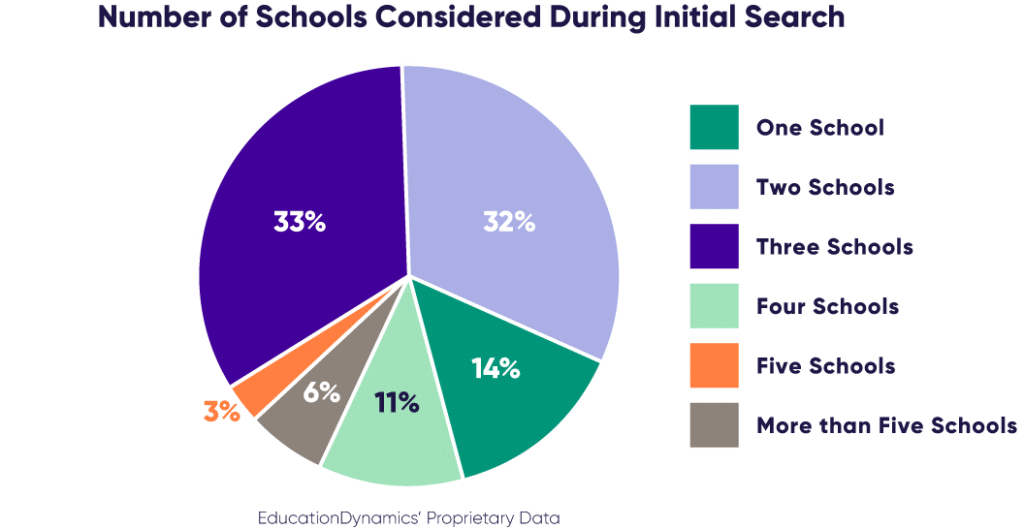
Showcase your institution as a preferred destination and impact prospective students’ final decision by providing informative content that offers deeper insights into your institution’s offerings and helps prospective students feel informed and confident about their potential fit and future at your institution.
Highlight your strengths through informative content across various channels:
- Search
- Social media
- Over-the-top (OTT) advertising
- Program Display
- Audio
- Video
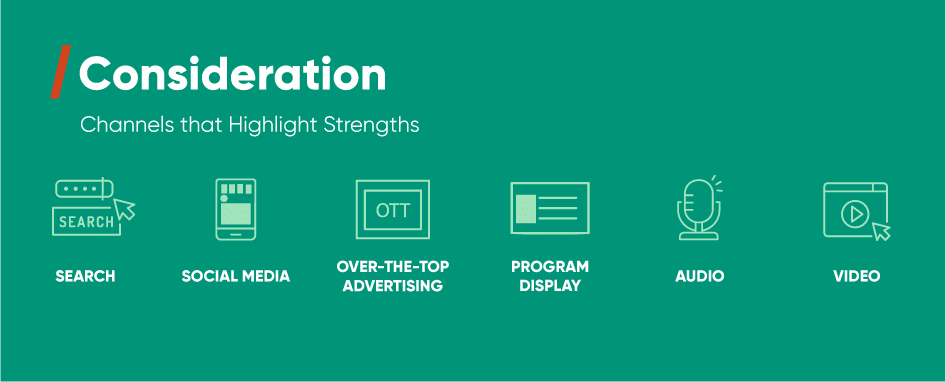
By providing informative, clear and confidence-building content that addresses student concerns, your institution can increase its visibility and solidify your institution as a top contender in the prospective student’s final selection process.
3. Conversion:
Prospective students compare their top choices and make their final decision. The communication strategy here should focus on addressing the prospective student’s final concerns, offering reassurance and providing clear and accessible information about their next steps.
During the conversion phase of the student enrollment funnel, prioritize creating a frictionless experience. By offering clear communication, readily available resources, and a streamlined application process, you can significantly increase your chances of converting prospective students into enrolled students, solidifying their decision to choose your institution.
Channels for increasing the likelihood of conversion during the conversion phase:
- Search
- Social
- SMS
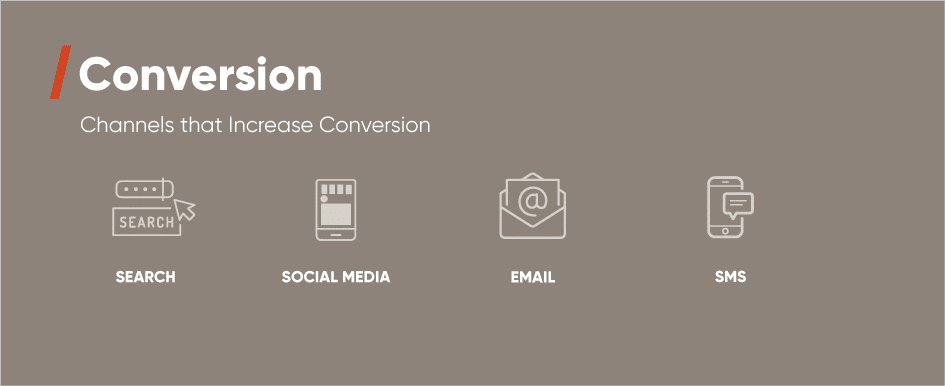
By providing clear guidance, addressing concerns and showcasing the value proposition of your institution, you can ensure a seamless transition from prospective student to applicant.
Your institution has successfully captured the attention of prospective students and established an initial connection. At this stage, students are dedicating time to carefully consider their top options for advancing their education. Maintain and deepen prospective students’ interest by delivering messaging that is personalized, detailed and addresses each prospect’s specific concerns and questions. The key to a successful lead nurturing strategy is to provide a supportive, no-pressure environment while supporting their decision-making process and nudging them closer to taking the next step with your school.
Channels that can maximize your lead nurturing efforts include:
- Search
- Social
- OTT
- Program Display
- Audio
- Video
- SMS
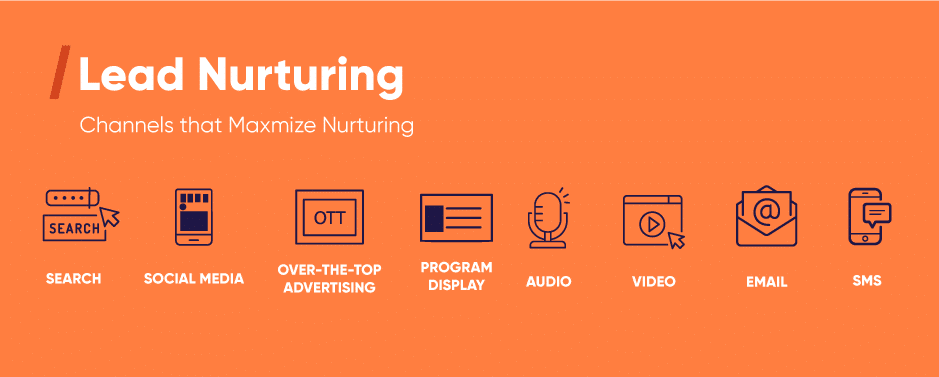
Truly cultivate an understanding and support for prospective students navigating through the application process by delivering messaging that inspires them to complete their educational journey, personalized guidance and reminds them of the enriching experiences that await them at your institution.
5. Enrollment
At this stage, prospective students have become applicants, now it’s a matter of getting them to enroll and move forward at your institution. Offering content that effectively addresses any final concerns and provides reassurance that their decision to enroll at your institution is the right choice, right fit and right time for them.
Convert your applicants into enrolled students with these channels:
- SMS
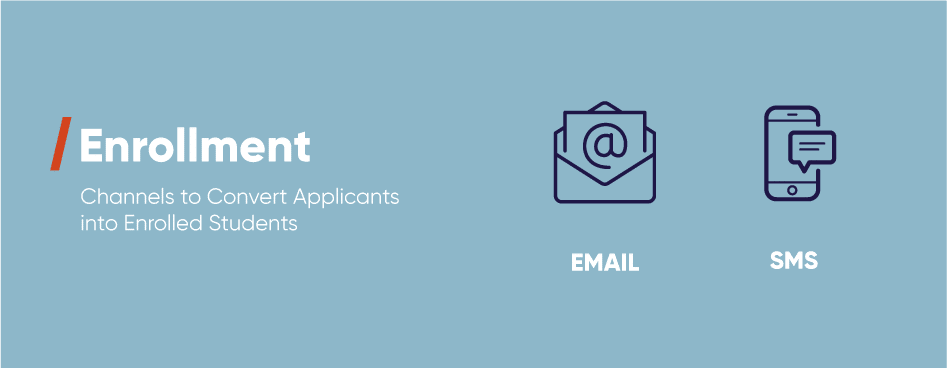
Feature content that addresses barriers such as affordability, mental burnout, and enrollment complexity by highlighting the availability of financial aid, scholarships, flexible payment options and personalized support services to promote streamlined enrollment process.
Utilizing email and SMS will be the most effective in delivering this type of content. Incorporating strategies such as targeted email campaigns and personalized phone calls can be effective. As long as the content you are offering provides clear and easy-to-follow instructions for the enrollment process, your institution can help eliminate any confusion or frustration and solidifying that the students’ decision to enroll at your school was the right one.
The Importance of Full-Funnel Marketing
At EducationDynamics, we have always taken a holistic approach to student recruitment and believe it is essential for long-term growth and sustainability. We have seen several shifts in the landscape that make a full-funnel marketing strategy more valuable than ever before.
Increasing Complexity in the Media Landscape
First, we see increasing complexity in the media landscape, from consumer behavior to advances in marketing channels. The average number of streaming hours consumed continues to rise. At the same time, ad-supported streaming platforms are growing in popularity and the social media landscape is fragmenting. In our latest Online College Students Report 2024, about 70% of online college students utilize primarily ad-supported streaming services and use YouTube, Spotify, YouTube TV, Netflix, and Hulu daily. These landscape changes are important in that they tell a story about where prospective students are spending their time online and how we can effectively reach them with advertising.
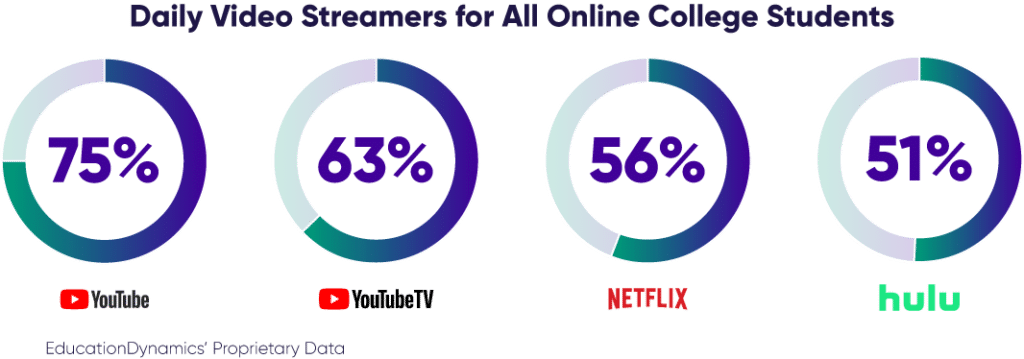
Changes in Prospective Students’ Search and Decision-Making Habits
Secondly, we are seeing changes in how prospective students are searching for and making decisions about higher education. As the focus on student loan debt and the value of higher education continues to be top of mind for students, we are seeing this manifest in prospective students doing more research even after the point of inquiry. In our 2024 Online College Students Report, 40% of online college students initially inquired at two schools and 21% inquired at three. Once they narrowed their selection 30% of online college students applied to two schools and 16% applied to three. Students are motivated to find the best value. They are therefore continuing to research past the point of inquiry and application to confirm their decision to invest—not just in tuition, but also their time and energy. Higher education marketers aim to respond by continuing to leverage various marketing channels to keep schools in the mix and reassure students why these schools are right for them and their circumstances.
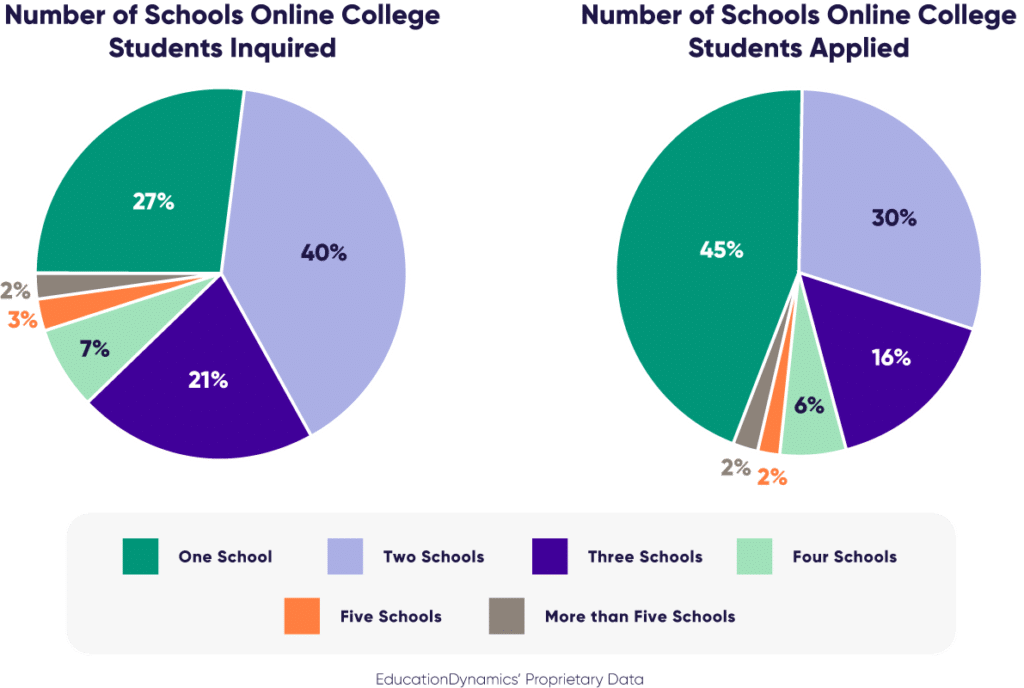
With all these changes in the market, winning universities and colleges are shifting their marketing strategies to meet this dynamic environment. By implementing a full-funnel marketing approach, institutions can benefit from:
- Increased Brand Awareness: A full-funnel strategy keeps your institution at the forefront of prospective students’ minds throughout their entire research journey. This consistent presence across various channels significantly increases brand awareness and strengthens institutional identity.
- Improved Student Conversion Rates: By nurturing leads with targeted messaging and valuable content at each stage of the funnel, you effectively guide them towards enrollment. This personalized approach fosters trust and increases the likelihood of conversion from initial inquiry to final acceptance.
- Stronger Return on Investment (ROI): Full-funnel marketing allows for targeted campaigns and data-driven optimization. This ensures your marketing budget is spent efficiently, reaching the right audience with the right message at the right time. You’ll see a significant improvement in ROI as you convert more qualified leads into enrolled students.
- A Better Student Experience: At the heart of a full-funnel marketing strategy is a desire to deliver a better student experience by meeting the student wherever they are on the journey. A strong full-funnel marketing strategy is empathetic to the prospective student, listens to their direct and indirect engagement cues, and delivers an experience that provides the right information at the right time and on the right platform.
By embracing a full-funnel strategy, institutions can effectively navigate the complex media landscape, address the evolving needs of prospective students, and ultimately achieve their enrollment goals.
Growing Enrollment with Full-Funnel Marketing
While the execution of a full-funnel marketing approach will vary depending on the institution, there’s a common thread: measuring success through Key Performance Indicators (KPIs) tailored to each stage of the funnel. This means monitoring and measuring the micro-conversions and engagements along the journey in addition to the more obvious traditional conversion points like requests for information, application and enrollment.
Here’s a breakdown of KPIs for different funnel stages:
Top-of-Funnel (TOFU):
- Brand Awareness: Focuses on metrics like impressions, reach, and brand recall to gauge how effectively your campaigns are building familiarity with your institution.
- Website Traffic: Tracks overall website visits and unique visitors to understand how well your TOFU efforts are attracting potential students.
- Engagement Rates: Measures user interaction on your website, such as time spent on pages, click-through rates on calls to action, and social media engagement, indicating deeper interest.
Mid-Funnel (MOFU):
There are two types of ‘Mid-Funnel’ stages in higher education marketing. We refer to the portion of the stage where the focus of marketing is on lead generation as pre-inquiry activities. Whereas, in admissions, enrollment and new student starts are the goal. We refer to this portion of the stage post-inquiry activities.
Pre-inquiry activities
Pre-inquiry activities include efforts made to connect with prospective students prior to directly contacting an institution for information. When tracking the effectiveness of these activities, higher ed marketers may consider these key metrics to determine their strategies’ ability to attract, engage and convert prospective students:
- Lead Generation: Tracks cost-per-lead (CPL) alongside the volume of qualified leads generated by your mid-funnel activities (e.g., webinars, downloadable content).
- Inquiry Volume: Measures the number of inquiries received through various channels, indicating a stronger interest in your programs.
- Content Engagement: Analyzes how users interact with your mid-funnel content (e.g., white papers, blog posts) to assess its effectiveness in nurturing leads.
Post-inquiry activities
Following prospective students’ application submissions, your institution should prioritize a smooth transition into enrollment. A frictionless enrollment streamlines the process, ensuring a higher conversion rate while enhancing the overall student experience. To track the effectiveness of your post-inquiry activities, consider the following metrics:
- Application Yield: Analyzes the percentage of applicants who complete the application process and submit their materials.
- Offer Acceptance Rate: Measures the proportion of admitted students who accept your institution’s offer which indicates program interest after the students’ initial hurdle.
- Lead Conversion Rates: Tracks the percentage of leads nurtured through email marketing or other channels that convert into applications.
- Application Completion Rates: Measures how many inquiries progress towards completing the application process.
Bottom-of-Funnel (BOFU):
- Enrollment Conversion Rate (Yield Rate): Tracks the percentage of admitted students who finalize registration and officially become enrolled to assess the effectiveness of the enrollment process.
- Cost-per-Enrollment (CPE): Analyzes the total marketing spend divided by the number of enrolled students, reflecting the overall efficiency of your marketing efforts.
- Deferral Rate: Analyzes the breakdown of admitted students who request to postpone their start date, providing insights into reasons for enrollment delays.
Monitoring these KPIs across the funnel stages provides valuable insights into the effectiveness of your full-funnel marketing strategy. This allows for data-driven adjustments to optimize each stage and ultimately improve your return on investment (ROI) for student recruitment.
By incorporating the costs associated with all stages of the funnel, you can leverage blended cost-per-enrollment (CPE) metrics. This provides a more holistic view of marketing effectiveness and allows you to utilize directional or causal analyses. These techniques go beyond simply observing correlations between upper funnel activities (such as brand awareness campaigns) and lead generation/bottom funnel results (like applications). They can help you understand the cause-and-effect relationships between these stages. Directional analyses can point you in the right direction, while causal analyses can provide more definitive evidence of the indirect impact that upper funnel activities have on lead generation and bottom funnel results.
Embracing a Full-Funnel Approach
As prospective students continue to search for higher education options and make decisions based on value, it is crucial for institutions to adapt their marketing strategies to meet this demand. Embracing a full-funnel approach will ensure that institutions stay competitive in the higher education market and achieve their enrollment goals.
Are you ready to transform your transform your marketing strategy to grow enrollment? Start a conversation with EducationDynamics today to discuss how we can help you implement a customized full-funnel strategy that drives enrollment growth and achieves your unique goals.
